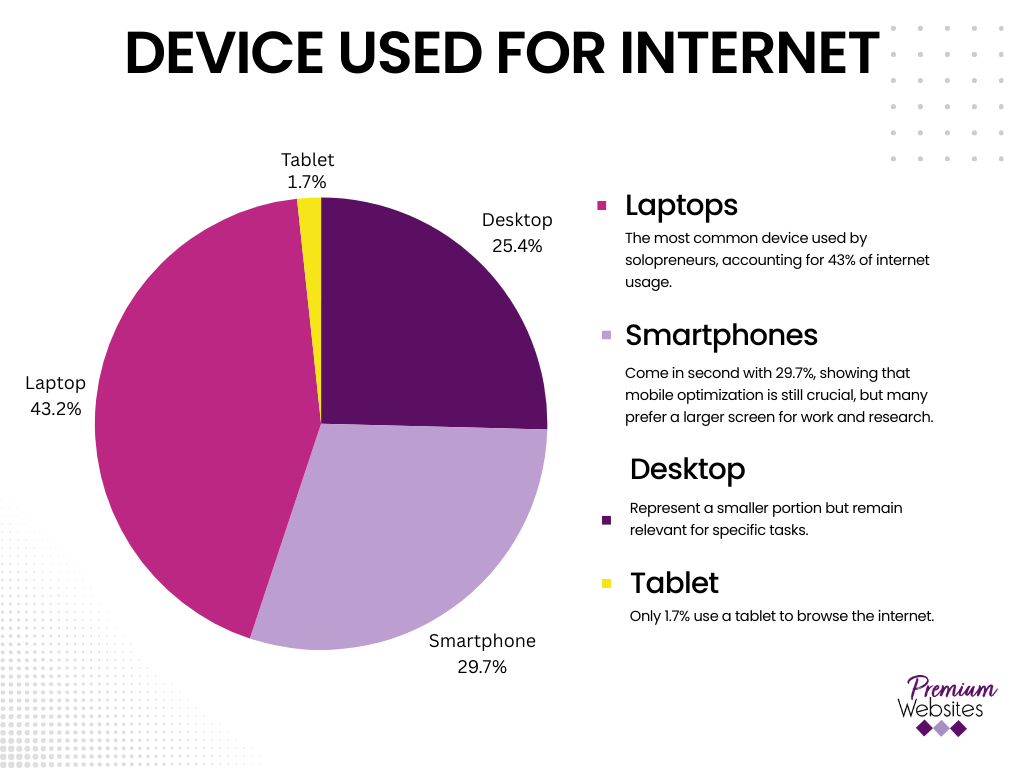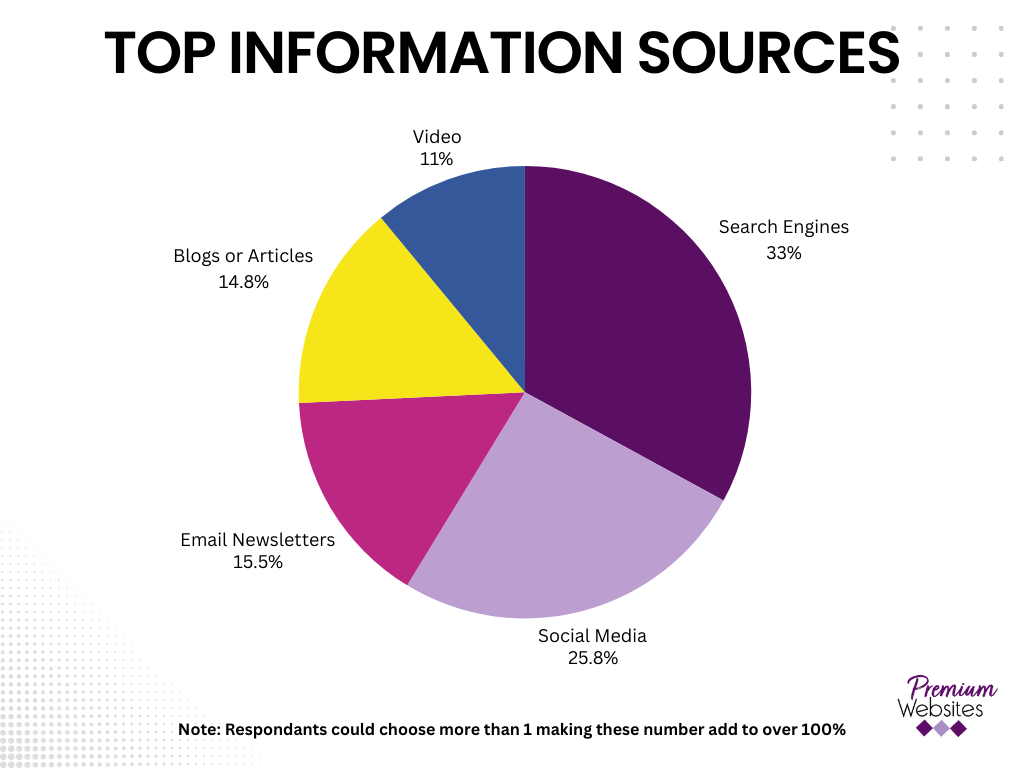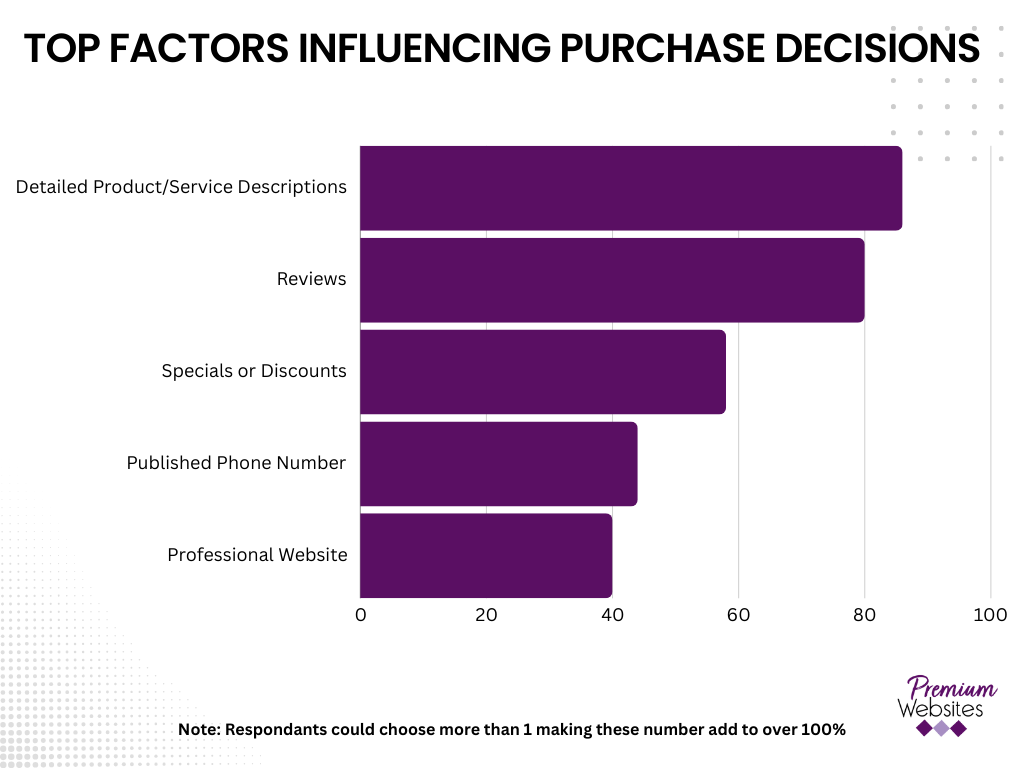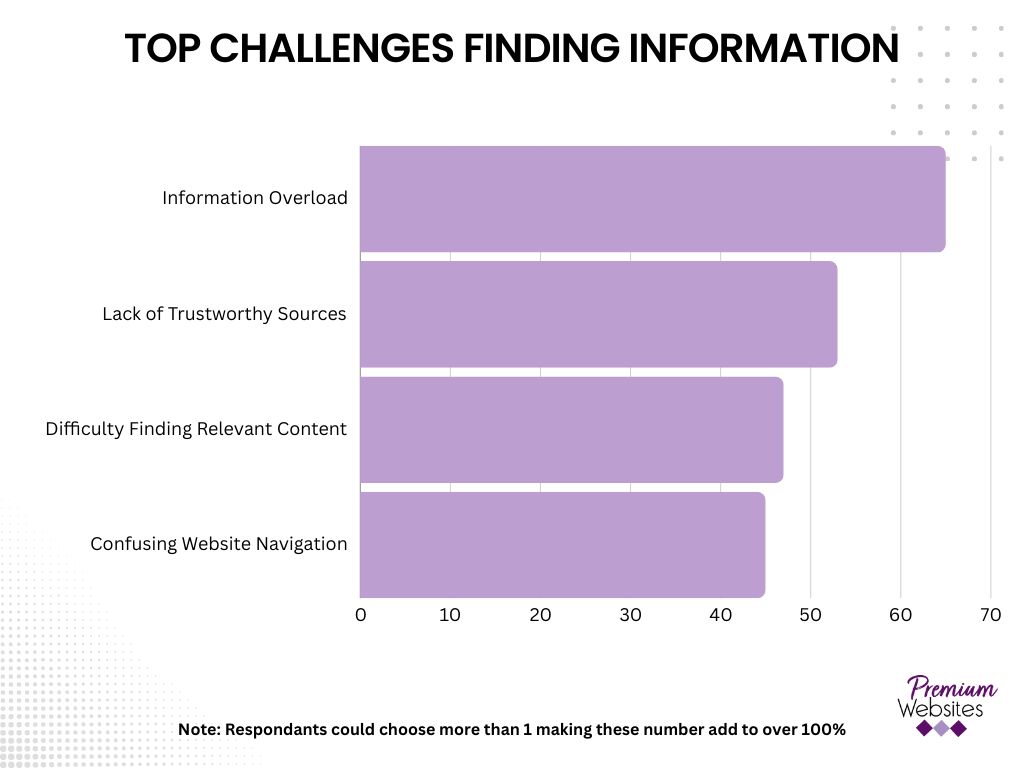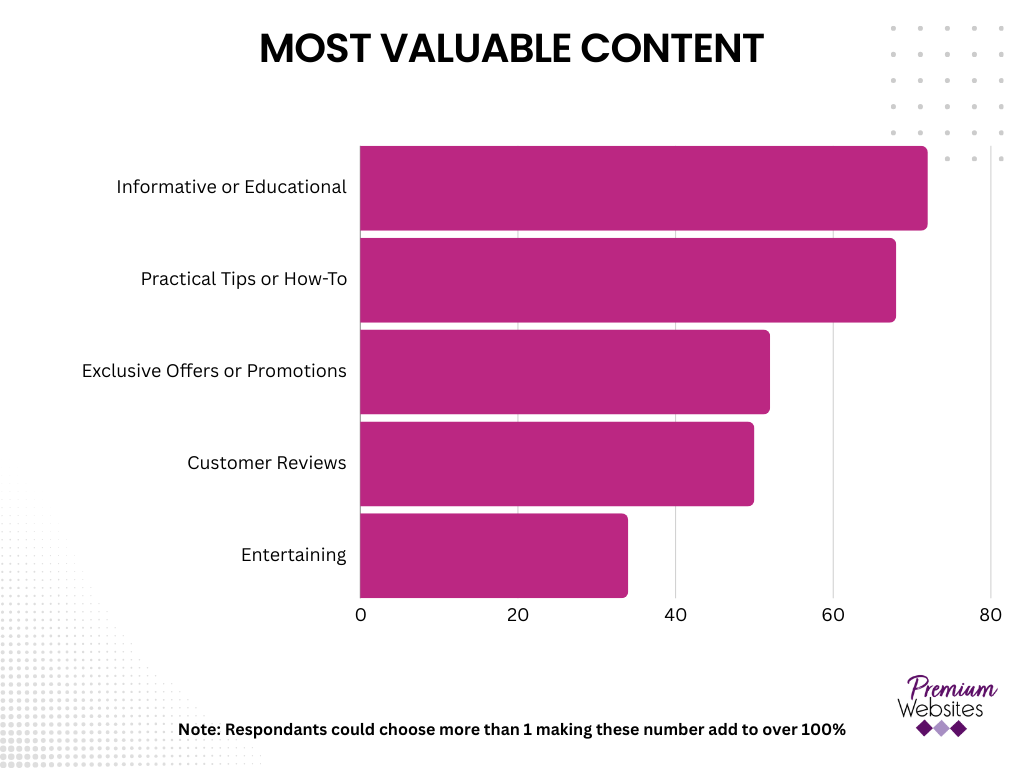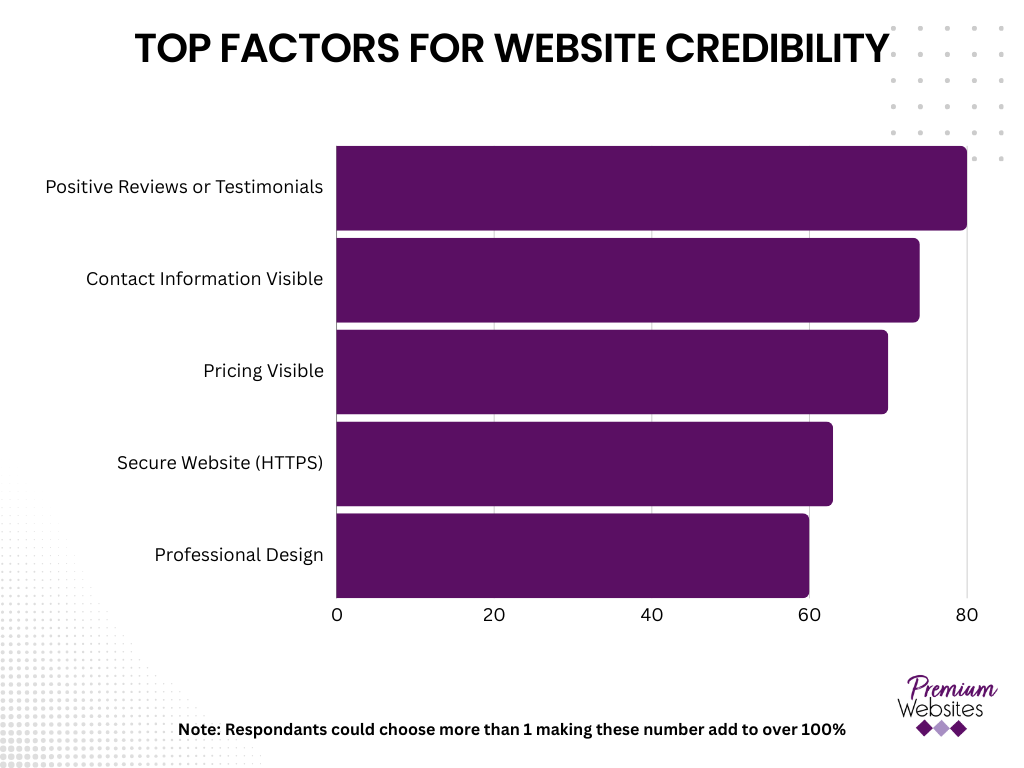
What Devices Are Consumers Using: How Solopreneurs Can Use Device Data to Enhance Their Marketing Strategy
As a solopreneur, it is important to understand what devices consumers are using. Knowing how your target audience interacts with the internet is crucial for shaping your marketing efforts. Are they using a mobile or desktop device? Device preferences—whether they use smartphones, laptops, or desktops—directly influence how potential customers experience your website, ads, and content. At Premium Websites, we believe that understanding these device trends can help solopreneurs like you optimize both your website and your digital marketing strategies for maximum impact.
In this blog post, we’ll break down the key insights from recent survey data and show how you can use this information to create a stronger online presence. This survey was conducted by Premium Websites and targeted to consumers.
Why Device Usage Insights Matter for Solopreneur Marketing
To effectively reach your audience, it’s important to know whether they’re browsing on a smartphone, laptop, or desktop. Your device data should guide the way you structure your marketing, ensuring that your website is accessible and engaging across all devices.
Let’s take a look at how consumers use the internet and what that means for your marketing moving forward. Keep in mind that you can look at your website analytics and see the exact percentage for your website.
Device Usage Breakdown
Pie Chart Analysis:
- Laptops are the most common device used by consumers, accounting for 43% of internet usage.
- Smartphones follow at 29%, emphasizing the growing importance of mobile-friendly design.
- Desktop computers come in at 19%, used primarily for tasks that require a more detailed, long-form browsing experience.
These insights are key to understanding how your audience navigates the web—and how you can meet them where they are.
In my business, my website analytics tell me that 80% use their desktop and 20% use a smartphone. Very different results from this survey. I am a Business to Business (B2B) business, which is likely the difference. Most people looking for website design services are searching while at work and using desktop devices.
I strongly encourage you to get the numbers for your website directly from your website analytics.
Step 1: Prioritize a Multi-Device Marketing Strategy
Creating a multi-device marketing strategy is essential for solopreneurs to effectively reach consumers where they spend their time online. Device preferences—whether it’s laptops, smartphones, or desktops—significantly affect how consumers engage with your marketing. But it’s not just about the devices. To get the most out of your marketing efforts, you also need to understand where consumers find information and what factors influence their purchasing decisions.
Why Device Usage Influences Marketing Strategy
Our survey data shows that consumers use a variety of devices for online browsing, but laptops remain the most common, followed closely by smartphones. This means that your marketing should cater to both mobile and desktop users, ensuring a seamless experience across all devices.
But device preference isn’t the only factor. Consumers rely on different channels to discover new products or services. The survey reveals that:
- Search engines are the most commonly used tool, with 33% of consumers relying on them to find new information.
- Social media follows with 25.8%, making it an important platform for solopreneurs to stay active and engaged.
- Email newsletters were used by 15.5% of consumers, highlighting the importance of maintaining consistent email marketing campaigns.
- Blogs and articles remain valuable, with 14.8% of consumers turning to written content for research.
- Video content is also effective, with 11% of consumers using this format to discover new information.
* Respondents could choose more than 1 source which is why these numbers add to more than 100%.
Top Sources for Finding New Information
These insights can guide solopreneurs on where to focus their marketing efforts. For example, ensuring your website ranks well on search engines through SEO is essential, while maintaining a presence on social media platforms like Facebook, Instagram, and LinkedIn can help you reach your audience where they spend their time. Additionally, producing engaging blog posts and videos will keep potential customers coming back for more in-depth content.
Factors That Drive Consumer Purchase Decisions
Once consumers find your business, several key factors influence their decision to make a purchase. According to the survey data, the most important factors are:
- Detailed product/service descriptions: With 86% of the respondents ranking this as the top influence, providing clear, comprehensive descriptions is critical.
- Reviews and testimonials: Social proof matters, with 80% of the respondents indicating that positive reviews play a major role in their decision-making.
- Special offers and discounts: Consumers are drawn to value, with 58% of the respondents noting that promotions and discounts can tip the scales.
- Published phone number for inquiries: Personal, accessible communication matters to 44% of the respondents, who expect the ability to contact you easily.
- Professional website design: A polished, professional look builds trust, with 41% of the respondents emphasizing the importance of a well-designed site.
* Respondents could choose more than 1 factor, making these numbers more than 100%.
Top Factors Influencing Purchase Decisions
Understanding these factors means solopreneurs should focus on presenting clear, detailed descriptions of their products or services, ensuring customer reviews are visible and easily accessible, and offering promotions where possible. Having a professional website that looks and functions well on both mobile and desktop devices is also crucial for gaining consumer trust.
Tailored Content for Each Device
Now that we know where consumers find information and what influences their purchase decisions, it’s time to tailor your content to the device they’re using. Here’s how to align your strategy across multiple devices:
For Laptop Users:
- Detailed Content: Laptop users are more likely to engage in long-form content like blog posts, in-depth product descriptions, and case studies. Make sure your website is optimized for desktop viewing with high-quality images and easy-to-read layouts.
- SEO and Reviews: Since search engines and reviews are top influencers, focus on optimizing your website’s content for SEO and ensure your customer testimonials are prominently displayed.
For Smartphone Users:
- Mobile-Friendly Design: With nearly 30% of users relying on smartphones, ensure your site is responsive and loads quickly on mobile. Shorter, actionable content like social media posts and quick product summaries work best for mobile browsing.
- Social Media: Since social media is a major source of information, solopreneurs should maintain an active presence on platforms like Facebook, Instagram, and LinkedIn, where mobile users are most active.
For Desktop Users:
- Professional Presentation: Desktop users still expect a highly professional design and engaging visuals. Focus on providing a seamless, high-quality experience with larger, detailed images, videos, and well-structured pages.
- In-Depth Content: Desktop users may spend more time researching, so give them access to rich content like webinars, product demos, and detailed articles that dive deep into your services.
Device-Specific Targeting for Ads
To further optimize your marketing, take advantage of device-based targeting on platforms like Google Ads or Facebook Ads. This allows you to deliver tailored ads based on the user’s device:
- Mobile Ads: Keep ads concise and make sure they direct users to mobile-optimized landing pages. Include tap-friendly call-to-actions.
- Laptop/Desktop Ads: Design ads with more detailed descriptions and visuals, and link them to landing pages with in-depth content that satisfies the needs of a more focused audience.
Actionable Takeaway: Customize Your Marketing Approach
By combining insights on device usage, consumer behavior, and purchase influences, you can craft a multi-device marketing strategy that resonates with your audience. Focus on ranking well in search engines, providing detailed descriptions and reviews, maintaining a strong social media presence, and ensuring your website is mobile-optimized and professional across all platforms.
Step 2: Optimize Your Website Based on Consumer Device Data
Optimizing your website is about more than just ensuring it looks good across devices. It also involves addressing common challenges consumers face when navigating online, providing valuable content, and ensuring your website is credible in the eyes of your audience.
Based on the survey data, here are the steps solopreneurs can take to create a high-performing website.
Challenges Consumers Face When Finding Information Online
Your website’s usability plays a huge role in whether or not a consumer stays to explore or leaves in frustration. According to the survey data, the biggest challenges consumers face when searching for information online include:
- Confusing navigation: A major pain point for consumers, meaning your website should be easy to explore with clear menus and a logical flow.
- Difficulty finding relevant content: If visitors can’t quickly find what they need, they’ll leave. Use intuitive search functions, clear CTAs, and well-organized categories.
- Slow load times: Consumers are increasingly impatient with slow websites. Ensure fast load times by optimizing images and using reliable hosting.
- Information overload: There is too much information that is not always accurate.
Top Challenges Consumers Face When Finding Information
By addressing these issues, you’ll improve your website’s user experience. Here’s how:
How to Solve These Issues:
- Improve Navigation: Simplify your website’s structure. Ensure that key pages—like product listings, service offerings, and contact details—are easily accessible from the homepage. If your navigation has more than 1 dropdown level, use landing pages instead. Flyout menus are not user friendly and need to be removed.
- Create Clear Paths to Content: Use distinct CTAs (calls to action), menu labels, and content categories to make navigation seamless. Make it easy for consumers to find product descriptions, blog posts, or customer testimonials.
- Prioritize Speed: Compress images, use a content delivery network (CDN), and minimize plugins to boost your website’s speed. A faster site will keep consumers engaged. If you are using hosting provided be Premium Websites, a CDN is included.
What Consumers Value Most in Online Content
Knowing what content consumers value most allows you to prioritize the type of information and resources you display prominently on your website. According to the survey, consumers value:
- Educational content: Consumers love learning from the brands they engage with. Offering how-to guides, industry insights, and detailed blog posts is key to attracting and retaining visitors.
- Clear product/service information: Detailed descriptions of your offerings are a must, helping potential customers understand the value and benefits of your products or services.
- Customer reviews and testimonials: Featuring real-life feedback reassures consumers that they are making a smart purchase decision.
Most Valuable Content for Consumers
Given these insights, here’s how to structure your website’s content:
How to Deliver Valuable Content:
- Provide Educational Resources: Dedicate a section of your website to in-depth blog posts, FAQs, or guides that help your audience solve specific problems.
- Clear and Detailed Product Descriptions: Each product or service page should provide thorough descriptions, including features, benefits, and pricing. Use bullet points and highlight key information.
- Showcase Testimonials: Dedicate space on your homepage and product pages for reviews and customer stories. Social proof helps build credibility and trust.
How Consumers Evaluate Website Credibility
Consumers are quick to judge a website’s trustworthiness. According to the data, the top factors that help consumers assess a site’s credibility include:
- Professional design: A polished, well-organized website instills trust and confidence. Sloppy design, on the other hand, raises red flags.
- Published contact information: Consumers want to know they can easily reach out if they have questions. Display your phone number, email address, and physical location prominently.
- Up-to-date content: A website with regularly updated blogs, news, or product listings signals that your business is active and trustworthy.
Top Factors for Website Credibility
To make sure your website meets these expectations:
How to Boost Website Credibility:
- Invest in Professional Design: Ensure that your website design is clean, modern, and professional. Use consistent fonts, a color palette that reflects your brand, and high-quality images.
- Display Contact Information Clearly: Feature your contact details in the header or footer of every page, as well as on a dedicated “Contact Us” page.
- Update Content Regularly: Keep your blog, products, and service listings current. Regularly post updates, new articles, and fresh reviews to show that your business is active. If you have a blog, look at your old posts and add any new information. Be sure to add the date you updated to post.
Actionable Takeaway: Refine Your Website’s User Experience
To create a high-performing website that drives conversions, focus on solving common user challenges, delivering valuable content, and establishing credibility. By addressing confusing navigation, slow load times, and difficult-to-find information, your website will be a go-to destination for consumers. Similarly, highlighting customer reviews, providing educational resources, and maintaining a polished design will instill confidence and trust in your visitors.
Summary: Leverage Device Data for Better Marketing Results
Understanding how consumers use their devices can transform your marketing strategy. At Premium Websites, we specialize in creating responsive, mobile-friendly websites that help small business owners like you reach your audience effectively—whether they’re browsing on a smartphone, laptop, or desktop.
Ready to optimize your website for all devices? Contact us today to see how we can help you grow your business.
Frequently Asked Questions (FAQ)
1. Why should I create a multi-device marketing strategy?
A multi-device marketing strategy ensures that your business reaches potential customers no matter what device they are using—whether it’s a smartphone, laptop, or desktop. Each device comes with unique user behaviors, so tailoring your marketing efforts to suit each one will help you engage your audience more effectively, increase conversions, and improve the overall customer experience.
2. How can I optimize my website for mobile users?
To optimize your website for mobile users, make sure your site uses responsive design, which automatically adjusts to fit different screen sizes. Prioritize fast loading times (under 3 seconds) and use simple, easy-to-tap navigation menus. Ensure your mobile version has clear CTAs, such as “click-to-call” buttons, and offers concise content that can be quickly consumed.
3. Why is it important to optimize for laptops if mobile is growing?
While mobile usage is increasing, our data shows that laptops are still the primary device for many solopreneurs and consumers. Laptop users often spend more time on websites and are more likely to engage in in-depth research. Optimizing for laptops ensures that these users have a rich, professional experience, which can help build trust and encourage deeper engagement with your business.
4. How do I know if my website is properly optimized for all devices?
You can use tools like Google Analytics and Google’s Mobile-Friendly Test to assess how your website performs on different devices. Look at key metrics such as bounce rate, session duration, and conversion rates for mobile, laptop, and desktop users. Regularly test your site on different devices and screen sizes to make sure it loads quickly, is easy to navigate, and functions properly.
5. What content works best for mobile users?
Mobile users tend to prefer short-form content that can be quickly consumed on the go. Focus on creating concise blog posts, quick product descriptions, and social media-friendly updates. Video content and images should also be optimized for fast loading and easy viewing on smaller screens.
6. How can I tailor my ads to different devices?
Most ad platforms, like Google Ads and Facebook Ads, allow you to segment your campaigns by device type. For mobile users, create short, clear ads with tappable CTAs, and ensure that the landing pages they link to are mobile-optimized. For laptop and desktop users, use more detailed visuals and copy, leading to landing pages that offer more in-depth content.
7. How often should I update my website’s optimization?
Website optimization should be an ongoing process. Regularly check your website’s performance using analytics tools, especially after major updates to your design or content. As device trends and user behaviors change, you may need to adjust your site’s functionality, speed, and design to ensure it stays optimized for all devices.
8. What are the top factors that influence consumer engagement on a website?
Consumers expect fast loading times, easy navigation, and responsive design across all devices. They also look for clear, concise information and a professional layout that’s easy to navigate. Ensure that your website meets these expectations to maintain high engagement and conversion rates.
9. How do I create a seamless experience across all devices?
Creating a seamless experience across devices starts with responsive design, which ensures that your website automatically adjusts to fit any screen size. Test your site on smartphones, laptops, and desktops to make sure it functions correctly on each. Prioritize user-friendly navigation, fast loading times, and consistent branding across all devices.
10. What’s the difference between optimizing for desktop versus mobile?
Desktop optimization often involves high-quality visuals, detailed navigation, and longer content since users tend to spend more time and engage with deeper content on larger screens. Mobile optimization focuses on speed, simplicity, and quick, clear interactions, as mobile users are typically browsing in shorter, more focused sessions.

